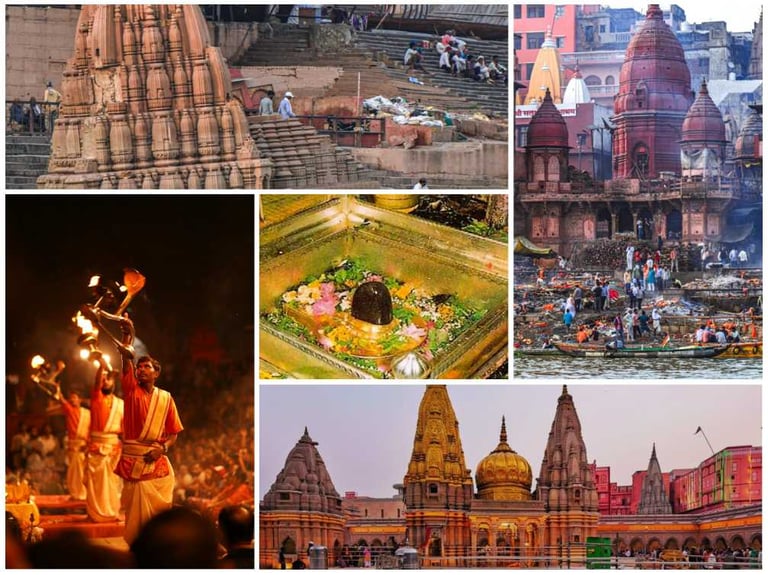5-Day Varanasi Itinerary
Plan your perfect 5-day trip to Varanasi! Explore Kashi Vishwanath Temple, witness Ganga Aarti, discover Sarnath, savor local food, and immerse in the spiritual charm of Banaras with this detailed itinerary and FAQs.
VARANASIUTTAR PRADESH
Arghyaraj Basu
6/16/20256 min read


Day 1: Arrival & The Grand Ganga Aarti Spectacle
Morning/Afternoon (Arrival & Check-in):
Arrive in Varanasi, either by air (Lal Bahadur Shastri International Airport - VNS) or by train (Varanasi Junction - BSB, or Banaras - BSBS, formerly Manduadih).
Transfer to your hotel, check in, and take some time to freshen up.
Enjoy your first local meal – perhaps a simple thali (plate meal) to ease into the flavors.
Late Afternoon (Ghat Exploration & Aarti Prep):
Head towards the iconic Dashashwamedh Ghat. Begin a leisurely walk along the ghats, soaking in the atmosphere. Observe pilgrims performing rituals, locals bathing, and the distinct architecture of the riverside steps.
Find a good vantage point for the evening ceremony.
Evening (Ganga Aarti at Dashashwamedh Ghat):
Witness the breathtaking Dashashwamedh Ghat Ganga Aarti. Arrive early (around 5:30 PM - 6:00 PM, depending on the season) to secure a good spot. You can choose to sit on the ghat steps or rent a boat for a unique view from the river. This deeply spiritual and visually stunning ceremony is an absolute must-see.
Dinner: Enjoy dinner at a rooftop restaurant overlooking the illuminated Ganga or dive straight into the bustling street food scene near Godowlia.
Day 2: Sacred Sunrise, Temple Trails & Old City Charm
Early Morning (Serene Sunrise Boat Ride):
Wake up before dawn (around 5:00 AM) for a truly magical sunrise boat ride on the River Ganges. This offers an unparalleled perspective as you witness the ghats gradually come alive with pilgrims taking holy dips, performing Surya Namaskar (sun salutations), and offering morning prayers.
Ask your boatman to highlight significant ghats like Manikarnika Ghat (the main cremation ground) and Harishchandra Ghat from a respectful distance.
Morning (Kashi Vishwanath Temple & Old City Delights):
After your boat ride, make your way to the revered Kashi Vishwanath Temple. Be prepared for strict security checks and potentially long queues, especially during festivals. Remember to store all electronics, bags, and leather items in designated lockers outside. Experience the divine darshan (sacred viewing) of Lord Shiva.
Explore the nearby Annapurna Devi Temple and the Vishalakshi Temple.
Immerse yourself in the labyrinthine alleys of Vishwanath Gali, where time seems to stand still. Browse shops selling religious paraphernalia, beautiful Banarasi sweets, and local handicrafts.
Lunch: Savor lunch at a traditional eatery tucked away in the heart of the old city.
Afternoon (Kal Bhairav Temple & Deeper Lane Exploration):
Visit the ancient Kal Bhairav Temple, dedicated to a fierce manifestation of Shiva, considered the guardian deity of Varanasi.
Continue your exploration of the intricate narrow alleys, stumbling upon hidden temples, artisan workshops, and observing the unique rhythm of everyday life in this ancient quarter.
Evening (Leisure/Relaxation):
Take some time to relax back at your hotel or enjoy a quieter stroll along a less crowded ghat to reflect on the day's spiritual journey.
Dinner: Indulge in an authentic Banarasi thali or continue your culinary adventure with more local street food discoveries.
Day 3: Sarnath Excursion & University Grandeur
Morning (Journey to Sarnath – The Cradle of Buddhism):
Dedicate a significant part of your day to Sarnath (approximately 10-15 km from Varanasi). This incredibly peaceful Buddhist pilgrimage site is where Lord Buddha delivered his first sermon after attaining enlightenment.
Explore the impressive Dhamek Stupa, the serene Mulagandha Kuti Vihar (featuring beautiful frescoes and a sapling from the original Bodhi tree), and the evocative ruins of ancient monasteries.
Visit the Archaeological Museum of Sarnath (closed on Fridays) to marvel at the iconic Lion Capital of Ashoka, India's national emblem.
Lunch: Enjoy lunch at a restaurant in Sarnath or return to Varanasi.
Afternoon (Banaras Hindu University & New Vishwanath Temple):
Head to Banaras Hindu University (BHU), one of Asia's largest residential universities. Its sprawling, verdant campus offers a refreshing contrast to the old city's chaotic energy.
Within the BHU campus, visit the New Vishwanath Temple (Vishwanath Mandir or Birla Mandir). This modern, white marble replica of the original Kashi Vishwanath Temple is spacious and offers an easier, often less crowded, darshan experience.
Evening (Local Markets & Banarasi Silk):
Immerse yourself in the bustling local markets of Chowk and Godowlia.
If you're keen on shopping, visit a Banarasi silk saree weaving center or a reputable silk shop. Witness the intricate craftsmanship involved in creating these world-famous sarees and consider purchasing an authentic textile or souvenir.
Dinner: Enjoy dinner at a restaurant specializing in North Indian cuisine, or try the rustic yet hearty baati chokha.
Day 4: Southern Ghats Serenity & Culinary Deep Dive
Morning (Assi Ghat & Revered Temples):
Begin your day at the southern tip of the city's ghats, at Assi Ghat. It’s a popular spot for morning yoga, spiritual discourses, and boasts a relatively calmer ambiance. You can also opt for a shorter boat ride here.
Visit the revered Sankat Mochan Hanuman Temple, dedicated to Lord Hanuman, known for alleviating troubles.
Visit the nearby Durga Temple (Monkey Temple), easily identifiable by its distinct red color and its resident monkey population (exercise caution and keep your belongings secure).
Lunch: Explore a different local restaurant for lunch, perhaps trying a regional specialty.
Afternoon (Varanasi Food Walk & Sweet Indulgences):
Dedicate your afternoon to a delightful culinary exploration. Varanasi is a paradise for street food enthusiasts.
Sample Tamatar Chaat near Chetganj, a unique savory and tangy creation.
Grab some crispy Kachori Sabzi for a traditional snack.
Indulge in various flavors of rich, creamy Lassi from famous shops like Blue Lassi or Pehelwan Lassi.
Conclude your food adventure with the iconic Banarasi Paan – a traditional betel leaf preparation.
Evening (Relaxation & Reflection):
Spend a relaxed evening at one of your favorite ghats, perhaps returning to Assi Ghat, simply observing the river, the people, and reflecting on the spiritual journey you've undertaken.
If interested, consider indulging in a traditional Ayurvedic massage to unwind.
Dinner: Enjoy a farewell dinner at a restaurant of your choice, celebrating your memorable time in Varanasi.
Day 5: Last Moments & Departure
Morning (Leisure & Departure):
Enjoy a relaxed breakfast at your hotel.
Depending on your flight or train schedule, you might have time for some last-minute souvenir shopping (e.g., wooden toys, religious artifacts, local sweets) or revisit a favorite spot for one last glimpse.
Departure: Check out from your hotel and transfer to the airport or railway station for your onward journey, carrying cherished memories of the mystical and captivating city of Varanasi.
Important Considerations for Your Trip:
Best Time to Visit: October to March offers the most pleasant weather, with comfortable temperatures for sightseeing. Summers (April-June) are intensely hot, and the monsoon season (July-September) can bring heavy rains.
Getting Around: Auto-rickshaws, cycle-rickshaws, electric rickshaws (e-rickshaws), and ride-sharing apps (like Ola/Uber) are readily available. Be prepared to walk extensively, especially in the old city's narrow lanes where vehicles cannot enter.
Dress Code: Modest and respectful attire is strongly recommended, particularly when visiting temples and religious sites. Cover your shoulders and knees.
Crowds: Varanasi is almost always bustling. Exercise patience and be prepared for crowds, especially during major festivals or peak pilgrimage seasons.
Hydration: Always carry bottled water and stay well-hydrated, especially in warmer months.
Flexibility: This is a suggested itinerary. Feel free to adjust it based on your personal interests, energy levels, and any unexpected discoveries you make!
Frequently Asked Questions (FAQ)
Q: What is the minimum number of days to spend in Varanasi?
A: While you can get a glimpse in 2 days, 3 days are recommended for a more relaxed and comprehensive experience that covers the main highlights including Sarnath. For a deeper immersion, 4-5 days, as outlined in this itinerary, would be ideal.
Q: Can non-Hindus enter the Kashi Vishwanath Temple?
A: Yes, people of all faiths and nationalities are generally welcome to enter the Kashi Vishwanath Temple.
Q: Is photography allowed inside the Kashi Vishwanath Temple?
A: No, photography is strictly prohibited inside the main Kashi Vishwanath Temple premises for security reasons and to maintain the sanctity of the shrine. Lockers are available outside to store electronic devices.
Q: What is the best time to visit Varanasi?
A: The cooler months from October to March are generally considered the best time to visit Varanasi for comfortable exploration and pleasant weather.
Q: Are there any entry fees for the Kashi Vishwanath Temple?
A: General darshan (viewing of the deity) is free of charge. However, there are specific fees for special aartis (rituals) and VIP darshan if you wish to participate in these for quicker access.
Q: How can I reach the Kashi Vishwanath Temple from my hotel?
A: The temple is located in the dense, old part of Varanasi. You can reach the vicinity by auto-rickshaw or e-rickshaw, but the final approach to the temple requires walking through the narrow, pedestrian-only alleys of Vishwanath Gali.
Q: Are there accommodations near the temple?
A: Yes, Varanasi offers a wide range of accommodations, from budget-friendly guesthouses and hostels to mid-range and luxury hotels. Many options are conveniently located near the ghats and the temple area.
Q: What is the significance of the Jyotirlinga at Kashi Vishwanath?
A: The Kashi Vishwanath temple is one of the twelve Jyotirlingas, which are supreme devotional representations of Lord Shiva. It is believed that Lord Shiva manifested as a fiery column of light (Jyotirlinga) in these twelve places. Kashi (Varanasi) is considered one of the most sacred of these sites, and a darshan here is said to grant liberation (moksha) from the cycle of birth and death.
Q: What is the local language in Varanasi?
A: Hindi is the primary local language. However, due to tourism, many people involved in the travel industry (hotel staff, guides, shopkeepers) also understand and speak basic English.
Q: Is Varanasi safe for solo female travelers?
A: Varanasi is generally safe, but like any crowded city, it's advisable to be aware of your surroundings, especially after dark. Stick to well-lit and busy areas, avoid walking alone in secluded lanes at night, and be firm but polite with touts. Dressing modestly is also recommended.
Enjoy your spiritual and cultural adventure in Varanasi!
